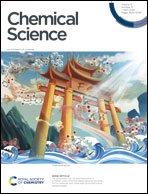Infrared spectroscopy reveals metal-independent carbonic anhydrase activity in crotonyl-CoA carboxylase/reductase†
Abstract
The conversion of CO2 by enzymes such as carbonic anhydrase or carboxylases plays a crucial role in many biological processes. However, in situ methods following the microscopic details of CO2 conversion at the active site are limited. Here, we used infrared spectroscopy to study the interaction of CO2, water, bicarbonate, and other reactants with β-carbonic anhydrase from Escherichia coli (EcCA) and crotonyl-CoA carboxylase/reductase from Kitasatospora setae (KsCcr), two of the fastest CO2-converting enzymes in nature. Our data reveal that KsCcr possesses a so far unknown metal-independent CA-like activity. Site-directed mutagenesis of conserved active site residues combined with molecular dynamics simulations tracing CO2 distributions in the active site of KsCCr identify an ‘activated’ water molecule forming the hydroxyl anion that attacks CO2 and yields bicarbonate (HCO3−). Computer simulations also explain why substrate binding inhibits the anhydrase activity. Altogether, we demonstrate how in situ infrared spectroscopy combined with molecular dynamics simulations provides a simple yet powerful new approach to investigate the atomistic reaction mechanisms of different enzymes with CO2.



 Please wait while we load your content...
Please wait while we load your content...